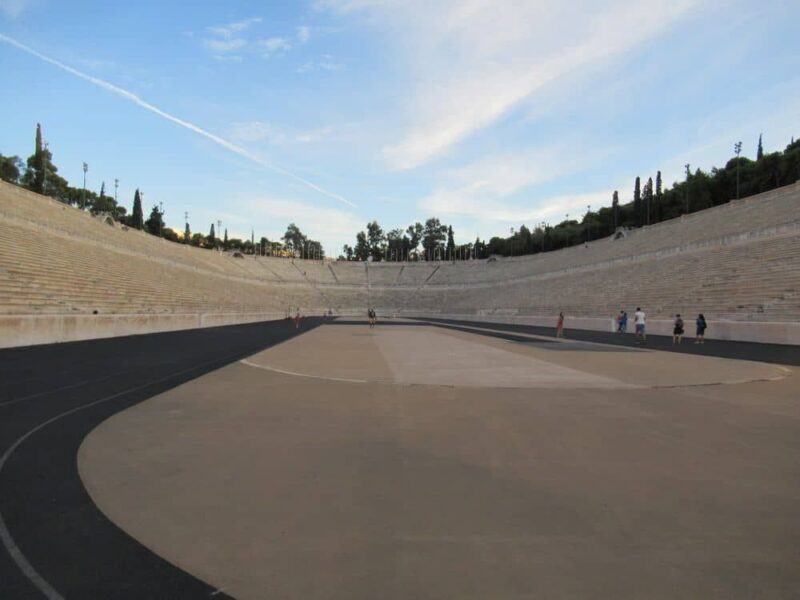It is impossible to remain indifferent when visiting the remarkable Acropolis Museum! One of the musts of any visit to the Greek capital, it is the most visited museum in Greece.
Located at the foot of the Acropolis, it magnificently highlights the treasures it houses.
In fact, we recommend that you visit the museum before seeing the Acropolis itself. It allows us to better understand this sacred site which represents the essence of classical culture in the ancient world.
Where is the Acropolis Museum?
The Acropolis Museum is located at Dionysiou Aeropagitou 15 in Athens, just opposite the ticket office for the Acropolis and Parthenon. On Google Maps.
Easily accessible by metro line 2 (red) Acropolis stop, Hop-On Hop-Off bus, or by foot, as it’s close to the Plaka shopping district.
Contacts :
- Phone +30 210 9000 900
- Email : info@theacropolismuseum.gr
- Website
Opening hours and holidays of the Acropolis Museum
Museum opening hours (admission possible until 30 mins before closing time):
- In high season (April 1st to October 31): Monday from 9am to 5pm, Tuesday to Sunday from 9am to 8pm except Friday from 9am to 10pm.
- In low season (November 1st to March 31): Monday to Thursday from 9am to 5pm, Friday from 9am to 10pm, Saturday and Sunday from 9am to 8pm.
Opening times for the archaeological digs beneath the museum:
- Summer: Tuesday to Sunday, 9am to 8pm ; Monday, 9am to 5pm
- Winter: Daily, 9am to 5pm
The Acropolis Museum is closed:
- January 1st (New Year’s Day), Orthodox Easter Sunday, May 1st, December 25 and 26
- The museum closes early at 3pm on December 24 and 31, as well as on Orthodox Easter Saturday. On Good Friday, the museum opens exceptionally from 12:00 to 18:00 only, and on Holy Saturday from 9:00 to 15:00.
Where to buy your tickets? What are the rates?
If you wish to visit on your own, you can buy your tickets:
- Directly at the museum’s cash desk
- On line, on the museum’s website
- Or on the GetYourGuide website, sold with an audioguide in English and which has the advantage of being cancelable and fully refundable up to 24 hours before the visit.
- There is also a combined ticket for the Acropolis and the Acropolis Museum with audioguide on Civitatis (not refundable) and on GetYourGuide (not refundable).
About the prices:
- Full price 20€
- Reduced price 10€
Reduced rate for European citizens over 65, non-European children and young people aged 6 to 25. On presentation of ID.
Free admission for European citizens under 25 (on presentation of proof of identity), people with disabilities and one escort… Further information on the Acropolis Museum website.
The museum is free on the following days: March 6 (Melina Mercouri Memorial Day), March 25 (National Holiday), May 18 (International Museum Day) and October 28 (National Holiday).
A modern setting to house ancient treasures
The museum was inaugurated on June 20, 2009. This ultra-modern building composed of steel, glass and grey cement is relatively neutral from the outside so that the container is replaced by the content.
4,000 objects are gathered here, of which at least 300 are true masterpieces. Everything on display comes exclusively from the Acropolis. Thus, you will not find in this museum any object from another part of Greece or even from another part of Athens.
On the outside square of the museum, discover under your feet the antiquities discovered during archaeological excavations. They have uncovered one of the oldest districts of Athens, and you can also visit them.
Before entering the interior, an owl (symbol of Athena) dating from the 5th century BC, standing on a steel pillar, welcomes visitors.
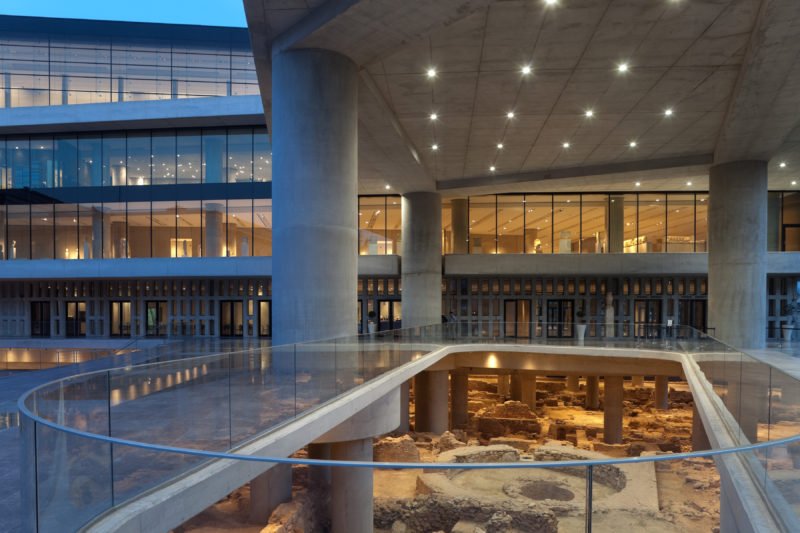
Ground floor of the Museum
After passing through the security checkpoint, buying your tickets and leaving your bags in the checkroom, you are ready to begin your tour of the museum. First of all, it begins with the gallery of the slopes of the Acropolis located on the first floor.
Showcases on the sides house finds from the sanctuaries founded on the slopes of the Acropolis as well as objects that the Athenians used in their daily lives from all historical periods.
Be sure to look down: the transparent glass floor offers a view of the archaeological excavations. The rising slope of this glass floor symbolizes the ascent to the hill of the Acropolis.
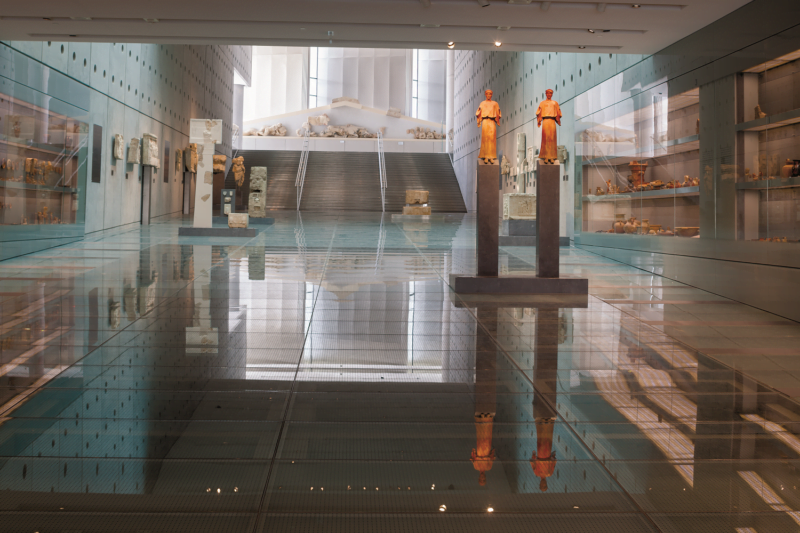
1st floor: an exciting forest of statues
On the first floor, objects dating from the Archaic period (900-480 BC) are displayed, an era characterized by smiling statues.
Admire the graceful marble statues, the fine carvings and drapery. Stop in front of the sphinx with its enigmatic smile, the calf bearer (one of the rare male statues) as well as the graceful kore (virgins). Some of the statues also still bear traces of paint.
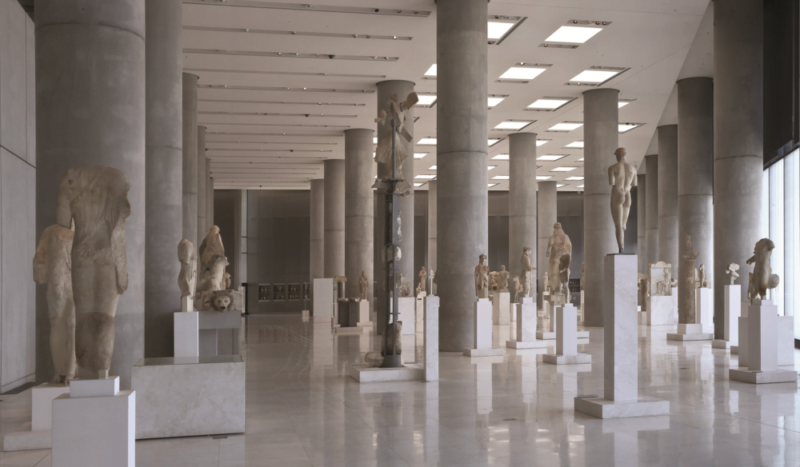
The scenography of the archaic gallery is particularly successful. Thanks to the airy presentation, we like the way the objects are highlighted by natural light and especially the fact that we can move freely between the statues. These are not lined up in a row. On the contrary, they are arranged so that they can be seen from all four sides.
After crossing this first room, take the time to admire the five caryatids, these statues of women who supported the Erechtaion (sanctuary built on the most sacred part of the Acropolis). The real statues are exposed here, in fact those that we see today on the Acropolis are reproductions. The sixth caryatid is in the British Museum in London. Acropolis Museum is hoping for his return to the fold, and an empty space has been reserved for him.
Here again, the visitor can walk around and admire the statues. And it is a treasure because the caryatids are as beautiful from the front as from the back, with their hair all different.
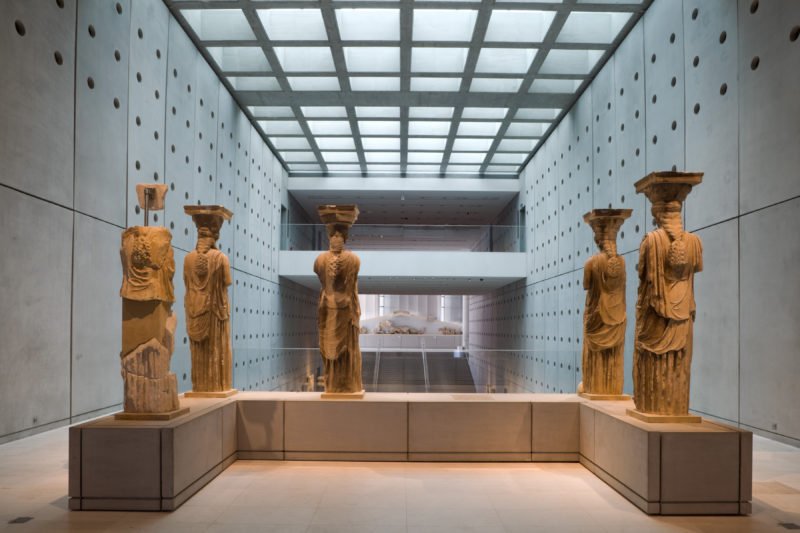
Top floor: the jewel of the Acropolis Museum
The third and last floor of the museum is offset from the other two in order to face the Acropolis. Through the bay windows, it offers a breathtaking view of the Parthenon.
But above all, this floor houses the sublime Parthenon gallery. A spectacular room. 50 steel columns of the same dimensions as those of the famous sanctuary. And 160 meters of friezes (originals or casts) reproducing the exact proportions of the Parthenon. A striking and extremely successful mix of antique and ultra-modern!
The frescoes represent the height of ancient art. Observe the finesse of the sculptures and the expressions of the characters.
Of all the frieze that remains today, only 50 meters are in the Acropolis Museum. 80 meters are exhibited in the British Museum, a block in the Louvre, while other fragments are scattered in various museums.
There is still today a controversy about “the Parthenon marbles”. Indeed, between 1801 and 1804, Lord Elgin, while he was the British ambassador to Constantinople, had sculptures removed from the Parthenon, with the permission of the Sultan. He then brought them back to his country before selling them in 1816 to the British Museum for a paltry sum.
While she was Minister of Culture, the actress and singer Melina Mercouri demanded in vain the return of the friezes.
Moreover, a great campaign has been undertaken to bring back these marbles to Greece. If you want to support this initiative, you can sign the petition on the “Bring them back” website.
Visit the Acropolis Museum
Furthermore, to fully appreciate this place and its treasures, we strongly recommend a guided tour. It changes everything!
There are several options for this:
Guided tour of the Acropolis Museum in small groups
With the local agency Alternative Athens, which offers a discovery tour of the museum in English every day. The visit is of quality and the guides are very professional. Information and reservations here.
Combo tour of the Acropolis and the Acropolis Museum with a private guide
When visiting Athens, if there are 2 must-sees, they are the Acropolis museum and the Acropolis! And to better understand the history and the treasures of its sites, don’t miss the private guided tours Combo Acropolis + Acropolis Museum. We spotted in particular this visit Ioanna, Acropolis and museum private guided tour, 3 hours with an english speaking license guide archeologist, but we have not tested it.
Don’t forget to buy your ticket before visiting: Ticket to the Acropolis + Acropolis Museum.
Visit with an audioguide in English
You can also choose an economical and very flexible solution. This is an English audio tour to download on your smartphone + the entry to the Acropolis Museum. You can buy it directly on Get Your Guide. Be sure to select option 2 to benefit from the audio tour of the Acropolis Museum in addition to the tour of Athens included in option 1.
That’s it, now you know everything about the Acropolis Museum! So before you start climbing the Acropolis or after visiting the museum, take a well-deserved break at the Acropolis Museum cafe. One of our favorites!
Laure M.

